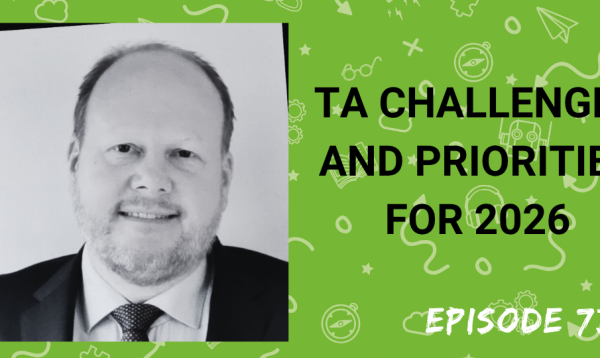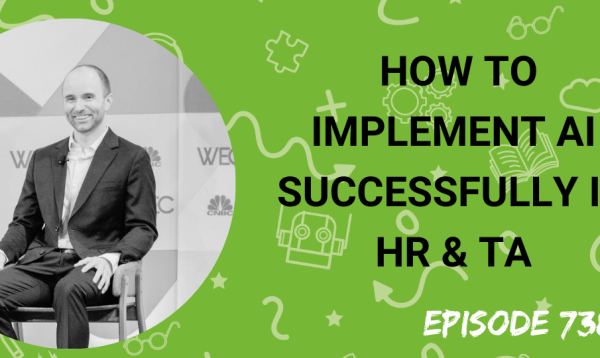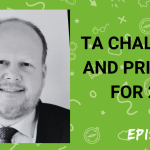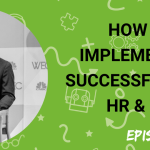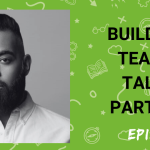It is fantastic to see the increasing use of data-informed strategies in talent acquisition. However, while the industry is making progress in this area, generally there is still a lot more to be done when it comes to the use of data in recruitment marketing. Most recruitment marketing is not as sophisticated targeted or optimised as it can be, and that’s a real problem for employers.
My guest this week is Theo Smith recruitment manager at The National Institute for Health and Care Excellence. NICE is an organisation with research and data at its core and Theo has been doing a great job at bringing an evidence-based approach to their recruitment marketing.
In the interview we discuss:
- NICE’s recruiting challenges and how they have changed over the last few years
- Evidence based recruiting and the power of in-depth research
- Reaching out to new communities of talent.
- Simple sources of talent audience data
- A/B testing to increase quality conversions
- The importance of specific language in job titles and keywords
Theo also talks about segmenting candidate journeys and the future of recruiting technology.
Subscribe to this podcast in Apple Podcasts
Transcript:
Matt Alder [00:00:00]:
Support for this podcast is brought to you by cultureamp. Eliminate the guesswork of company culture with cultureamp, the world’s largest independent employee feedback platform. Culture Amp goes beyond aggregating survey results to deliver rich insights and data driven action plans on an easy to use interface. With a powerful platform, science backed surveys and a focus on customer success, cultureamp helps you increase employee engagement and and build a positive company culture. Start developing a deep understanding of your employees experience today by visiting cultureamp.comFuture that’s cultureamp.comFuture.
Matt Alder [00:01:02]:
This is Matt Alder. Welcome to episode 176 of the Recruiting Future podcast. It’s fantastic to see the increasing use of data informed strategies in talent acquisition. However, while the industry is making progress in this area generally, there’s still a lot more to be done when it comes to the use of data in recruitment marketing. Most recruitment marketing is not as sophisticatedly targeted or optimized as it can be and that’s a real problem for employers. My guest this week is Theo Smith, Recruitment Manager at the National Institute for Health and Care Excellence. NICE is an organization with research and data at its core and Theo has been doing a great job at bringing an evidence based approach to their recruitment marketing. Hi Theo, and welcome to the podcast. Hello.
Theo Smith [00:01:55]:
Hi. How you doing, Matt?
Matt Alder [00:01:56]:
Good. Fantastic to have you on the show. Could you just introduce yourself and tell everyone what you do?
Theo Smith [00:02:02]:
Yes. I’m Theo Smith and I head up recruitment at nice, the National Institute of Health and Care Excellence. So we look after the pathways, the guidance. We do research to basically decide if you’re in hospital and you’re getting some treatment, which route you’ll take, which technologies, which drugs will be available to you, going through the NHS and the health, amongst many other things.
Matt Alder [00:02:28]:
Now, I could imagine that that creates some interesting recruiting challenges. Tell us about the sort of talent that you, that you recruit and the challenges that that might throw up.
Theo Smith [00:02:41]:
Yeah, I guess there’s probably a misconception that because we’re an armed science body of the Department of Health, that we are like an NHS organization. But actually the talent that we require to do the work that we do is fairly different. And it’s a real challenge to identify these people because often they come in from academia or they may come from consultancies or possibly even pharmaceutical companies. We’re talking about health economists or health researchers, systematic reviewers, and sometimes those individuals are building economic models from the very beginning. Sometimes that happens from support from the academic institutes and sometimes actually they’re just systematic reviewers. But ultimately there’s a very small amount of these people available to us and often they come with PhDs in health economics, Master’s qualifications. So that obviously provides us with a significant challenge over the years. But actually what’s happened for us as an organization is the variety of skills that we now require has broadened. So when we were in our first 10 years of operation, we’re 20 years this year. And what we realized in first 10 years is that we needed four different areas of skills required for four different areas of work that we did within the health sector. Roll on five years and that became 14 areas and roll on another five years and that’s increased even more. So it’s not just that we need these individuals, but actually the specialist skills that we require has broadened as well over the years. That’s made it much more difficult 5, 10 years ago where we were able to attract the right talent, now we’re finding it much more difficult. And with technological advances and with the volume and variety of information and content that we all have to sift through in our daily lives has made it really difficult for us. And ultimately that’s why I came in 12 months ago to help with that challenge.
Matt Alder [00:04:42]:
And how do you go about solving that challenge? Because you’re obviously looking for very, very special people. There aren’t, there aren’t very many of them. You know, how do you find them, how do you get the word out, how do you sort of persuade them to join the organization?
Theo Smith [00:04:55]:
So when I joined, my background is, is a mixed bag. I’ve worked with an executive search, I’ve worked in 360 recruitment, I’ve worked in house, I’ve worked for media buying agencies, RPO businesses. So when I came in with that variety of experience, you have to really look at the organisation, look at their challenges and then identify where the opportunities are. And that’s what I did in the first three months at nice, really was an interim role to come and help them solve the problem and then to decide what to do from there. So the way I like to look at it, Matt, is an evidence based recruitment approach. Because actually the work we do at NICE is evidence based. We put in two to three to four years of research to provide the evidence to make decisions around what technologies, what drugs are used within the health sector. And I thought it was quite fitting that we took a similar approach. So we looked at some of the data to inform us on why we were struggling, where these people were hanging out, you know, which companies they likely worked for. There was a misconception when I walked around and I started talking to hiring managers that we were losing people’s pharmaceutical companies. But actually when I delved deeper, we would actually take in more people from pharmaceutical companies than we were losing. But it’s the perception that you have. So there was a lot of focus in the wrong areas around attracting talent. And what we actually found out is three core areas. These technical analysts, what we call them, the systematic reviews health economists come from. And it is the pharmaceutical companies, it is consultancies and it is academia. And we just not put any focus around reaching out to those communities and speaking to them. And we’d certainly not done anything around lifting the blinds and opening the curtains to what life is like at nice, which have made it a really big challenge for us because although people had a lot of respect for who NICE are and what we do, those who had heard about NICE guidance on the news or work within the sector, but actually nobody truly understood what it was like to be John sat in a chair at night working in a technical analyst role. So we’ve had to do a lot of work around actually lifting the blinds and opening the curtain so people could get an idea. But it’s all being backed by the research and not your typical wide volumes and variety of data. Actually we’re talking about accessing simple bits of information here, utilizing LinkedIn to understand where our technical analysts worked previously and where they move on to. It’s not rocket science, but actually building on all those different data points and identifying all those different bits of information, building the Personas through surveys and through meeting up with working groups and through really getting underneath the skin of who we are as an organization has helped us to target those individuals more effectively.
Matt Alder [00:08:02]:
Now some really interesting stuff there and I want to dive in a bit deeper into, you know, how, how you’ve done some of that. But I suppose what’s interesting for me, you know, with this sort of evidence based approach to recruiting, you’re obviously dealing with a lot of perceptions that might have been there for years about what was, what was kind of going on with, you know, where people were leaving, where people were coming from. Did you find it easy to challenge those perceptions when you had the evidence or, or was that, was that still, you know, something that took bit of work to get people on board with?
Theo Smith [00:08:35]:
Well, I suppose when you’ve got the evidence it always helps. And when you’re dealing with people who have PhDs, who have, you know, high level of academic qualifications and experience. Actually, evidence is a really good way to convince people to change their thinking and their viewpoint. Actually, I found NICE has been highly receptive to the ideas and to the messages that we’ve been sharing. And I think it’s for that reason if you present it in a way that’s accessible and that the highly managed community can understand, then they’re much more likely to respond positively towards it. So when I’ve worked in other organizations, whether they’re big aerospace companies, manufacturing organizations, engineering businesses, the way that you deal with these challenges is very different. And you don’t need to come up with as much evidence as what we’ve had to come up with here, but it’s just around ensuring that the audience that you’re working with, in this instance, the highly managed community, that it resonates with them, that they understand it, that they buy into it and that they believe in it. And at a ground level, if we can create that commitment and belief. But actually through creating working groups that have the involvement of some senior members of nice, what we’re doing is we’re actually working from both the bottom up and the top down. So that then what you find is it’s much easier to get stuff done.
Matt Alder [00:10:02]:
Absolutely. And that makes. That makes perfect sense. So obviously, you know, you’ve done the research, you’ve kind of identified the type of people you’re looking for and where those people are and presumably, you know, a fair about their motivations. You built Personas, you know, all of that great stuff. How did you move forward with that? How did you actually sort of translate that into practice, source these people and persuade them that NICE was the place that they should be working?
Theo Smith [00:10:36]:
So what we found is through doing the research, the surveys, the Q and A, sitting down with the teams, is that they were spending time online. So they were spending time. Our technical analysts were spending time on Twitter as a news channel, quite a high proportion of them. And they were also spending time on Facebook groups. So what we were quite quickly able to do is a B test, engaging with those communities, just with job content initially to see whether or not we were creating more applicants, more relevant applicants. Because what we found is our old channels to market were actually creating a lot of applicants, but didn’t have the right skills and capabilities to do the job. So it was making it difficult for us by actually targeting people on Facebook and on Twitter with these jobs, we were straight away able to improve the conversion of quality candidates. But what we also did is we everything came back to the research, Matt. So out of the research there were keywords coming out that helped us target those individuals better, but also those keywords we utilized throughout of all the communications. So all the research done up the front end was all the information that then went into the content, whether it was the job copy, the job advert, whether it was the targeting on social media, whether it was the headline that we used to get the hook. What we found is that this information done up front was helping us significantly throughout all of that recruitment. So better conversion, better quality of candidates that were coming through. And we were also able to do that within the advert copy. So what we found is that a lot of our adverts had just been reproduced time and time again and thrown back out there and they didn’t really speak the language of who we are today as an organization. So we did some work around trying to understand who we are as individuals within nice what the team makeups look like and actually trying to get that information into the top of an advert. So we found that technical analyst wasn’t resonating, didn’t make sense on Google or indeed we were struggling to change technical analysts with HR and with finance. But we still needed to solve the problem quickly. So it was around using some of those keywords in the first lines to improve the applicant. So are you a health economist or systematic reviewer within the health sector, for example? And we found by making some of those changes, we reduced the amount of inappropriate applicants. So we go from 20 to 30 applicants who were just not right down to one or two. Now where that became really important for us in the hiring managers is we’re an arm’s length Bodie. We assess every single applicant that comes through. So if we get 100 applicants, we will score each one of them independently. We’ll have a panel of two to three people who will do that. And so you can understand quite quickly the numbers. If you’re getting 20 to 30 applicants that are inaccurate because of the wording that you’re using, it’s putting a big strain on the workforce through that process. So for us it wasn’t just around attracting the right people because we were struggling to identify them. Actually it was improving the overall quality of those people going through because there was a, a lot of time and energy and effort being taken to work through all of those applicants. So it’s been a big time saver as well as improving the, the quality of applicants for us.
Matt Alder [00:14:23]:
That’s really interesting and that and and that kind of leads nicely to my. My next question, which was, you know, sort of based on, you know, the evidence that you had and also, I suppose, the different, you know, volumes and quality of applications. Did you feel that you had to make any changes to your actual recruitment process or the candidate experience? Was that part of what you’ve done?
Theo Smith [00:14:50]:
Yeah, it’s something that we’ve now got to look at because over the last 12 months, what we’ve done is we’ve completely turned recruitment on its head. We outsource recruitment administration. So that had an impact on the way that we worked and the quality of the candidate experience, because a lot of it was automated emails and we needed to put in the kind of the human element. So that’s kind of. You’ve hit there on the next stage. For us, what we needed to do was increase the volume of applicants, the right types of applicants, and know that that was working, and then find a way to ensure that the journey that they take is a good one. I mean, the direction we’re going in is we’ll want to segment the journey dependent on the type of role and the department. So if you’re a technical analyst, you may well want to have the opportunity to communicate your experience in written form, answering questions and to be assessed on that basis, because that’s part of the work that you do. However, if you’re a developer, we want to make sure that it’s a very simple process to apply for a job, whether that’s a CV or we can find other routes to apply gamification, whatever it may be, building Lego. But the reality is that is the journey that we now go on over the next 12 months, because we started to solve the problem of where these people are, how we’re going to target them and how we’re going to start to engage them with us, and what type of content is going to start to resonate with them. And now we’ve got that. We’re going through the process of the technology where we can house it all and we can streamline it and improve it. But for me, it all had to start with the research, the evidence to guide us in the steps that we were going to take. So, you know, there are probably a lot of organizations sat out there thinking, how do we do employer branding? How do we identify those people that we’re really struggling to find? And for me, it’s actually about stripping things back. We can’t all have a global head of employer branding who can guide us and support us from the top down. Sometimes actually, it’s around taking what you have, what’s available to you, what you can assess, what data points are there. They don’t need to be big, complex pieces of data. Actually, they can be very simple pieces of information that when you put together, they create a narrative, a story that you can utilize, and that becomes quite powerful. And I think that’s what we’ve been able to achieve here in the last 12 months. But, yeah, the next step will be then to ensure that we’ve got improved technology, processes, systems, and that we can make sure that the candidates get a great experience. Because if I’m honest with you, we are absolutely not there yet. The candidates still have to follow what is a rigorous, archaic process by nature of who we are and what we’ve been a part of. So that’s one of the big challenges that we’ll face now over the next 12 months.
Matt Alder [00:17:47]:
Matt, final, final question. I know that you’re someone who sort of keeps a keen eye on, you know, developments in the, in the. In the recruiting market in general, sort of, particularly around technology. Where do you think recruiting is heading sort of generally in the next 18 months to two years? What are you. What are you sort of looking forward to seeing in the way of, you know, new developments or new practices or new technology?
Theo Smith [00:18:12]:
So I think there’s a lot of talk about the big blue sky, about all the big developments within, whether it’s artificial intelligence or all the variations of however you want to define it. But actually, the reality for me is I see and hear a lot of people who are in the trenches, so to speak, who are still just trying to find a way to improve their organization, the recruitment process, piece by piece. And you see it in the marketplace, if you listen to candidates talk about their experience, often it’s fairly poor. And even those organizations that have the budget and the time and the focus to invest in the technology to improve that journey, actually, we’re still limited in terms of the organizations that are implementing the things that really make the difference. So, you know, personally, I’m a people person. I think that it has to be people focused. We have to think around the journeys of the individuals and whether that’s a marketing approach. And we’re setting it up so that people can click to apply as quickly as they can click to buy. I think that’s fine and it will have its place. But I think the human element, the human approach is still going to be really significant and important to ensuring you get the right positive journey throughout that process. So the technologies that will support us in achieving that, and especially that will support us in achieving it in a small way are the things I’m going to be most excited about. So, for example, I mean, you have, you have these people on the show talking about the technology in the future, what they’re going to be doing. But you know, job boards as an example, it’s evolving and changing at a rapid rate. And the way that we buy ads and that we promote ads and that we share our adverts to people. So for me, this is a real area of interest and the way that we can utilize job boards in the future in a real simple way. And it’s something that we’re doing here and I think also where we can find other ways to simplify what we’re doing and streamline it. You know, you’ve seen organizations now, whereas historically, if you needed to go and buy media, you go to a big media buying agency. Well, everything’s being digitalized. So you can jump online now and you can type in that you need a developer in Manchester and the digital technology can tell you where and when that you’re going to post it. So for me, it’s not about the really big exciting things that I’m focused on. It’s actually those smaller organizations, those new tech startups. If you go to some of these key events, it’s those small companies that are solving small problems. Because for me, Matt, they’re the things that are actually having the biggest impact for me because we’ve not got the budget and the time to invest big, complex technology into our organization.
Matt Alder [00:21:16]:
Theo, thank you very much for talking to me.
Theo Smith [00:21:18]:
Lovely. Thank you, Matt.
Matt Alder [00:21:20]:
My thanks to Theo Smith. You can subscribe to this podcast in Apple Podcasts or via your podcasting app of choice. The show also has its own dedicated app, which you can find by searching for recruiting future in your App Store. If you’re a Spotify user, you can also find the show there. You can find all the past episodes@www.rfpodcast.com on that site, you can subscribe to the mailing list and find out more about working with me. Thanks very much for listening. I’ll be back next week and I hope you’ll join me.


